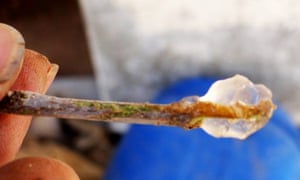The Guardian
Link
A Syrian civil defence group has accused the government of President Bashar al-Assad of using napalm on a town near Damascus, the latest escalation in a conflict that has seen the use of chemical weapons and indiscriminate aerial bombing campaigns.
If true, the attack would be the second serious allegation of napalm use in the Syrian war. In 2012, a BBC crew in Aleppo province witnessed what they described as a “napalm-like” attack on a school.
The latest allegations come just over a week after the UN security council passed a resolution that would allow investigators to identify the perpetrators of chlorine attacks in the country, widely believed to be conducted by the Assad regime.
They also come almost exactly two years since the infamous sarin gas attack in the Damascus suburb of Ghouta that killed more than a thousand people and nearly triggered American air strikes against Assad’s forces.
The latest allegations come just over a week after the UN security council passed a resolution that would allow investigators to identify the perpetrators of chlorine attacks in the country, widely believed to be conducted by the Assad regime.
They also come almost exactly two years since the infamous sarin gas attack in the Damascus suburb of Ghouta that killed more than a thousand people and nearly triggered American air strikes against Assad’s forces.

Syrian civil defence volunteers said the Assad regime dropped four barrel bombs containing napalm on Tuesday afternoon on the electricity company district in the town of Daraya, triggering huge fires which were only brought under control in the early hours of the morning.
“The wounded were treated under the light of the fires,” said Abu Suleiman, a pseudonym of the commander of Daraya’s civil defence team. “There were massive fires and the civil defence was completely paralysed in dealing with them.”
The attack was part of a wave of barrel bomb raids and missile strikes against the town, which has been besieged for more than two years and is controlled by the opposition.
Unverified footage and images from Daraya posted online and gathered by the civil defence showed the aftermath of the attacks, with large plumes of smoke, blackened buildings and raging fires.
Hamish de Bretton-Gordon, a former commanding officer of the UK Chemical, Biological, Radiological and Nuclear (CBRN) regiment and Nato’s Rapid Reaction CBRN battalion, said the footage appeared consistent with the aftermath of napalm attacks.
“It is likely that it is napalm,” he said. “Napalm seems to fit the bill.”
The civil defence said it was collecting samples from the attack sites for chemical analysis to prove the alleged use of napalm.
Napalm is an incendiary weapon that includes both fuel and a gel substance that adheres to skin and burns intensely when it combusts. Protocol III of the Chemical Weapons Convention prohibits the use of incendiary weapons on civilian targets and on military targets surrounded by concentrations of civilians.
The attack was part of a wave of barrel bomb raids and missile strikes against the town, which has been besieged for more than two years and is controlled by the opposition.
Unverified footage and images from Daraya posted online and gathered by the civil defence showed the aftermath of the attacks, with large plumes of smoke, blackened buildings and raging fires.
Hamish de Bretton-Gordon, a former commanding officer of the UK Chemical, Biological, Radiological and Nuclear (CBRN) regiment and Nato’s Rapid Reaction CBRN battalion, said the footage appeared consistent with the aftermath of napalm attacks.
“It is likely that it is napalm,” he said. “Napalm seems to fit the bill.”
The civil defence said it was collecting samples from the attack sites for chemical analysis to prove the alleged use of napalm.
Napalm is an incendiary weapon that includes both fuel and a gel substance that adheres to skin and burns intensely when it combusts. Protocol III of the Chemical Weapons Convention prohibits the use of incendiary weapons on civilian targets and on military targets surrounded by concentrations of civilians.

De Bretton-Gordon said the attack was likely a result of the increasing military pressure facing the regime and in reaction to the chlorine resolution, which was backed by Russia, despite its unflinching support for Assad.
He said it was probably also a tool to increase the psychological pressure on the opposition.
“In stark terms it’s no more dangerous than highly explosive barrel bombs but it’s horrific in the way it burns and how the jelly sticks to people,” he said. “It’s just another step up in the level of dreadfulness.”
The Daraya Media Center, a group of activists inside and outside the city, said the fires spread to civilian areas but wounds were limited because many fled to the appointed shelters when the attacks began.
“The people have become used to this and are calling on the silent international community to move to save those who are left,” a spokesperson said.
Suleiman said the volunteers faced great difficulty controlling the flames because of a supply shortage as a result of the ongoing siege. Though the number of wounded were few, those who were injured suffered primarily from burns.
Suleiman said the volunteers faced great difficulty controlling the flames because of a supply shortage as a result of the ongoing siege. Though the number of wounded were few, those who were injured suffered primarily from burns.
• This article was amended to 13 August 2015 to remove a description of the Syrian Civil Defence as “aligned to the opposition”. The SCD argue that they are a neutral organisation and not aligned to any political group.

No comments:
Post a Comment